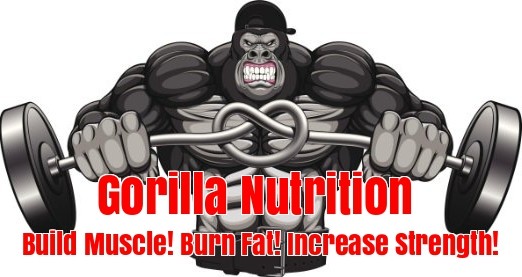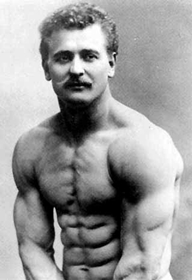Click Here to Sign Up for Your Free Bodybuilding Magazine Subscription
Bodybuilding History Timeline
Eugen Sandow The Father of Modern Bodybuilding
The timeline of bodybuilding can go as far back as the ancient Greeks as well as the Egyptian societies. Both of these societies saw muscle as a celebration of human development and they were well aware that the regular lifting of stones and rocks in various sizes will increase strength.
In fact, if we are looking to create a reasonable timeline of bodybuilding then we need to include the physical culture that can be traced all the way back to the 11th century India where men started developing the knowledge that lifting stone dumbbell weights, which were known as Nals, would enhance both health and stamina, helping the individual to overcome the daily challenges of life and gyms were commonplace all over India during this time.
India continued its promotion of this "physical culture" which by the 16th century was thought to have been what India's national pastime was. But the idea of developing your body's ability to hold more muscle and show that muscle off to competitors was something that only started 300 years later.
Bodybuilding was not called bodybuilding when it first started, it was only when Mr. Eugene Sandow (born Friedrich Muller), who was born in 1867 decided to call the sport "physical culture". Sandow was himself previously a performing strongman in Europe and on arriving in America went on to promote the first bodybuilding show in history with a prize money of $2,500 and the golden stature of Eugene Sandow, which still continues today at the Mr. Olympia.
Eugene Sandow arrived in America and started promoting his first "bodybuilding" show which he called "The Great Show" held in 1891. Judging criteria back then were laid out to award competitors for more than just showing muscle size, the criteria the first judges were looking for was; general development, condition and actual tone of muscle-tissue, balance of development, and the general health of the competitor's skin.
1890-1929 THE EARLY PERIOD
As the 19th century ended more and more people took an interest in weightlifting as a form of entertainment, health benefits were not considered yet. The attraction to weight-training in those days had nothing to do with showing off a glorious physique but to perform incredible feats of strength and calling themselves professional strongmen, like Eugene Sandow was.
It should be noted that by 1930 the concept of symmetry and aesthetics was beginning to change things. The gap between an unsightly strongman, someone who's grossly overweight and a bodybuilder was slowly being bridged by exercising to achieve a balanced physique with relatively low body-fat.
1930-1970S AN OLD CULTURE SOLIDIFIES
The '30s started with what is now affectionately known as "the golden age of bodybuilding". It was a time when all gyms and the many different associated practices like training in groups or posing before mirrors become very commonplace among its followers.
The Californian Coast, enjoyed the best of the golden age when weightlifting and pumping iron was on the beachfront for both amateur and professional bodybuilders. The well-known and most famous of these Californian beach hangouts was in Santa Monica, at Muscle Beach.
Bodybuilding competitions intensified and the AAU (the Amateur Athletic Union) started the first Mr. America contest in 1939, where the participants, who were not strictly bodybuilders, had to demonstrate their athletic skill. Modern day bodybuilding had started with the Mr. America which was won by John Grimek in 1940.
By comparison John Grimek and Steve Reeves held a massive amount of muscle for Joe Public, their incredible muscle size actually became an important catalyst that created a whole new direction in the art of physical improvement. As a result, bodybuilding became more popular than it was and the quality of muscle we saw on the physique's that competed also improved. When Steve Reeves appeared on magazine covers looking like a movie star with a perfectly proportioned physique it increased the popularity of bodybuilding even farther. When Steve won the Mr. America and the Mr. Universe title people said he was the greatest bodybuilder, ever.
1980-PRESENT TIME BODYBUILDING'S RECENT HISTORY
The 1980s was the fitness boom, it affected everything, including our health. Bodybuilding was no longer a dirty word associated with dirty weight boys pumping iron in a garage. The fitness boom started a crossover effect into bodybuilding that was going to benefit everyone.
Big time actors like Chuck Norris or Sylvester Stallone became noticeably more muscular, it was very good for bodybuilding when famous athletes like Carl Lewis and Ben Johnson turned up to compete looking ripped to threads with loads of muscle mass.
With the whole ethos of bodybuilding being based on the typical diet and weight training that a normal person should do, it was only a matter of time before it got adopted by our mainstream society for two reasons. Firstly, to increase their profile and secondly to enhance performance.
Everything changed and some bodybuilding commentators regret the general trend that was following aesthetics and balance suddenly gave way to a muscle mass-at-all-costs approach, with all top placers going to the competitor with the most size, during the '90s and after 2000.
Competitive bodybuilders were also becoming more muscular with an increasing emphasis on size dictated a more extreme approach to physical development. Although anabolic steroids had already been used by bodybuilders before the 1980s, stacking anabolics all the many different types of steroids (by using more than one steroid at one time) using insulin and other dangerous growth hormones.
With improved steroid mixing regimes, improved training techniques, and an increase in dietary strategies, witnessed the meteoric rise of 6-time Mr. Olympia winner Lee Haney. Standing 1.81m tall (5'9") his physique, standing onstage with 240 pounds of muscle surpassed anything bodybuilders had seen to that point.
When he retired, the six times Olympian, Haney had finally beaten Arnold's long standing record, and surpassed Arnold with his unstoppable muscular development. Lee Haney was not alone, there were other notable bodybuilders like Dorian Yates, Lee Labrada, Vince Taylor, and Shawn Ray.
fact, most professional bodybuilders in this new era have demonstrated a very distinctly different, massively defined physique that seeks to be extreme but it is prevailing. Just when we all thought that Dorian Yates had effectively redefined what a massive physique is, along came Ronnie Coleman who beat Dorians top bodyweight by over 20lbs.

